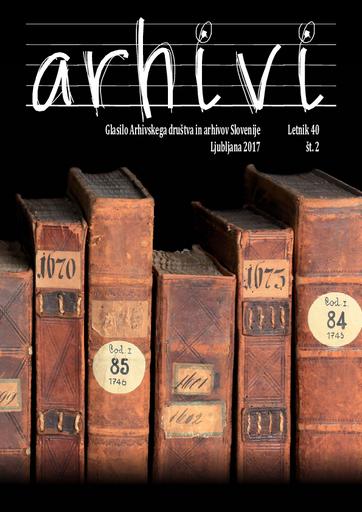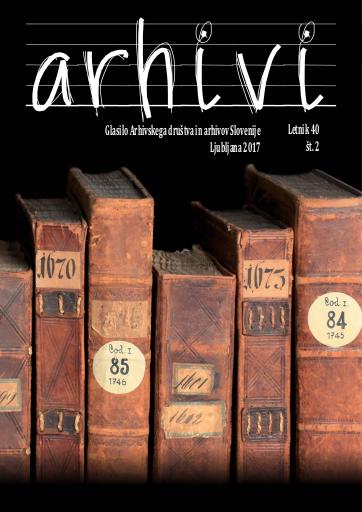/
Serijske publikacije
/
Arhivi
Samostani in župnije. Inkorporacije in patronati samostanov v današnji Sloveniji

Avtor(ji):Vincenc Rajšp
Soavtor(ji):Gregor Jenuš (gl. in odg. ur.), Dunja Mušič (teh. ur.), Petra Markuš (prev.), Tanja Martelanc (foto.)
Leto:2017
Založnik(i):Arhivsko društvo Slovenije, Ljubljana
Vir(i):Arhivi, 2017, št. 2
Jezik(i):slovenščina
Vrst(e) gradiva:besedilo
Ključne besede:ČLANKI IN RAZPRAVE, redovi, samostani, patronati, župnije, ARTICLES AND PAPERS, orders, monasteries, patronage, parishes
Avtorske pravice:

To delo avtorja Vincenc Rajšp je ponujeno pod Creative Commons Priznanje avtorstva-Nekomercialno-Deljenje pod enakimi pogoji 4.0 Mednarodna
Datoteke (1)

Ime:ARHIVI_2017-2.pdf
Velikost:8.87MB
Format:application/pdf
Stalna povezava:https://hdl.handle.net/11686/file25397
Opis
Feudal lords (Eigenkirchenherren) incorporated parishes in monasteriesw here they were exercising their rights of patronage. Patrons in the Slovene linguistic area were feudal lords, Aquileian patriarchs, and Salzburg bishops. The oldest incorporation was the incorporation of Kamnica parish into the monastery of St. Paul in Carinthia by the Spanheim family. In the following centuries, all medieval male and female monasteries but Carthusians were given patron parishes. Cistercian monasteries in Kostanjevica and Stična and Teutonic Order owned the most patron parishes.
Metapodatki (12)
- identifikatorhttps://hdl.handle.net/11686/41528
- naslov
- Samostani in župnije. Inkorporacije in patronati samostanov v današnji Sloveniji
- Monasteries and Parishes. Incorporation and Patronage of Monasteries in the Present-Day Slovenia
- avtor
- Vincenc Rajšp
- soavtor
- Gregor Jenuš (gl. in odg. ur.)
- Dunja Mušič (teh. ur.)
- Petra Markuš (prev.)
- Tanja Martelanc (foto.)
- predmet
- ČLANKI IN RAZPRAVE
- redovi
- samostani
- patronati
- župnije
- ARTICLES AND PAPERS
- orders
- monasteries
- patronage
- parishes
- opis
- Although pastoral care was not the primary task of medieval orders and monasteries, they began to get involved in parish pastoral care gradually. Parish founders or owners granted parishes to monasteries for economic reasons. Parishes were sound economic outposts, owing to »prebends«, therefore donations enabled monasteries to strengthen their economic base, be it for the main activity or other tasks given to them by donors (defence against external »enemies«). Monasteries appointed priests – vicars in the parishes to perform pastoral care. Initially, external priests were appointed, however, over time monasteries started to appoint their own priests. Vicars and especially monastic priests were doubtlessly connected to monastic spirituality that they spread to other parishes. Monasteries had different numbers of parishes. Benedictine monasteries St. Paul and Admont (both in Austria today) had a large number of parishes in Styria, the most patronages in Carniola were owned by Cistercian monasteries Stična and Kostanjevica, while Teutonic Order also had several parishes in Styria and Carniola. Patron parishes were also owned by female orders, such as Dominican nuns in Radlje and Studenice. Monasteries lost their role as patrons within parish organisational network with church reforms implemented by Joseph II and related dissolution of monasteries. The link between monasteries and parishes later gained negative connotation although all of the assets of the dissolved monasteries and not only those of parish churches were mostly intended for the new organisation of parishes.
- založnik
- Arhivsko društvo Slovenije
- datum
- 2017
- 01. 01. 2017
- tip
- besedilo
- jezik
- Slovenščina
- jeDelOd
- pravice
- licenca: ccByNcSa
